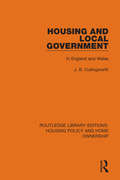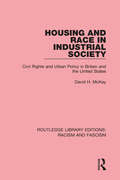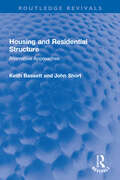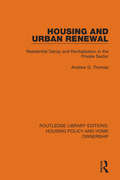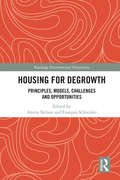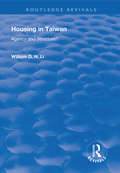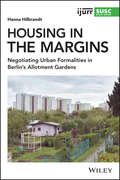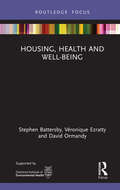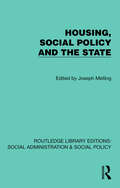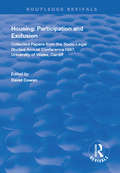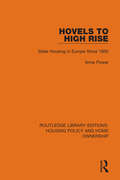- Table View
- List View
Housing and Domestic Abuse: Policy into Practice (Routledge Advances in Sociology)
by Yoric Irving-Clarke Kelly HendersonHousing and Domestic Abuse provides an analysis of how housing policy has been historically utilised in responding to domestic abuse. The authors trace the history of policy from the feminist roots of the refuge movement, to the use of ‘anti-social behaviour’ legislation to address abuse, and the current proposals being considered. The UK government and devolved governments in Scotland and Wales are currently making significant changes to the ways they address domestic abuse, including involving housing policy in their responses. This book provide details of the differential approaches of the Scottish and Welsh governments and proposes a ‘whole housing approach’ to addressing abuse. Readers will gain a detailed knowledge of historic, and current policy and practice in this area. They will also benefit from insights from two of the leading scholars in their respective fields of housing and domestic abuse policy and practice. This book will be of interest to academics, policy makers and practitioners across the fields of housing and domestic abuse policy and practice, as well as students studying social policy more broadly.
Housing and Local Government: In England and Wales
by J. B. CullingworthOriginally published in 1966 and written at a time when UK housing policy was undergoing major changes, this volume provides a substantial historical introduction which outlines the development of housing policy in the UK from the mid 19th – mid 20th Centuries. Discussion of the administrative framework, the powers of local housing authorities, housing standards, finance and the improvement of older housing follows. Other issues covered include the social aspects of housing and the role of the state and the objectives of state action.
Housing and Public Policy (Routledge Library Editions: Public Policy)
by Stewart LansleyHousing in the UK and globally has long been an area of central and local government concern, and this reflects its vital importance for both individual and social welfare. Despite increased public expenditure on housing in the post-war years housing remains a major problem area of social and economic policy. While housing standards have risen on average, significant sections of the community continue to endure poor housing conditions and prospects. Originally published in 1979, this study considers the role of public policy in housing, presenting a critical and contemporary account of policies in the late 20th century. The central theme emphasises the importance of extensive local and central government involvement in meeting housing need and ensuring fairness in housing provision. It thus presents an opposing view to those who argue that market forces should have a free rein in shaping housing development.
Housing and Race in Industrial Society
by David H. McKayThis is a comparative study of the relationship between civil rights law, housing and urban policy in Britain and the United States. It focuses on the ways in which governments have attempted to remove racial discrimination and disadvantage in private and public sector housing. The study, first published in 1977, does not simply consist of an account of administrative and judicial attempts to remove discrimination. A major concern is to place civil rights laws in their total political, economic and social environments. The book explains and compares the nature of racial residential change in both countries, and assesses the impact of civil rights law on existing patterns of discrimination and disadvantage. Other public policies, in particular housing and urban policies, are examined and their relationship to anti-discrimination measures is analysed. In explaining differences between the two countries, emphasis is placed on the role of government in urban society, the political economies of urban areas, and the social and political differences between minority groups. Finally, the study identifies the limits to effective civil rights law enforcement and provides some indication as to the policy alternatives open to decision-makers in the two countries.
Housing and Residential Structure: Alternative Approaches (Routledge Revivals)
by John Short Keith BassettFirst published in 1980, Housing and Residential Structure was written to take stock of the many changes that had recently taken place in explanatory approaches to housing markets and residential structure. The book is divided into three parts. Part One focuses on the demand-orientated approaches of human ecology and neo-classical economics. Part Two discusses the institutional approaches with reference to an analysis of private and public sector housing in Britain, drawing on illustrative material from North America and France to aid the comparative analysis of institutional structures. Part Three is devoted to an evaluation of the Marxist approaches to housing and residential structure from Marx and Engels to Castells and Harvey.
Housing and Social Transition in Japan (Housing and Society Series)
by Richard Ronald Yosuke HirayamaBringing together a number of perspectives on the Japanese housing system, Housing and Social Transition in Japan provides a comprehensive, challenging and theoretically developed account of the dynamic role of the housing system during a period of unprecedented social and economic change in one of the most enigmatic social, political, and economic systems of the modern world. While Japan demonstrates many of the characteristics of some western housing and social systems, including mass homeownership and consumption-based lifestyles, extensive economic growth and rapid urban modernization has been achieved in balance with traditional social values and the maintenance of the family system. Helpfully divided into three sections, Housing and Social Transition in Japan: explores the dynamics of the development of the housing system in post-war Japan deals with social issues related to housing in terms of social aging, family relations, gender and inequality addresses the Japanese housing system and social change in relation to comparative and theoretical frameworks. As well as providing challenges and insights for the academic community at large, this book also provides a good introduction to the study of Japan and its housing, economic, social and welfare system generally.
Housing and Technology: Special Focus on Zimbabwe (SpringerBriefs in Environment, Security, Development and Peace #37)
by Innocent Chirisa Abraham R. Matamanda Siphokazi Rammile Mario MaraisThe housing and human settlement sector is fast changing, and technology is making it more complex than ever before. With reference to Zimbabwe, a developing country in Southern Africa, the essence of this book is to bring out housing as an issue within the technology debate and practice. The following themes emerge from the 6 chapters in the book: • The characterisation and conceptualisation of housing and technology and the nexus of both • The complexity of housing challenges and the problems governments face in providing adequate housing, especially for the poor • Diverse practices in housing construction through the application of different typologies of technology • Assessment of the feasibility of technologies in housing development in Zimbabwe by mirroring them against global experiences. • Discussion of alternative policy approaches that may guide technology integration in housing development. This book will excite scholars and practitioners in urban and development studies, construction project management, urban sociology, geography, real estate together with policymakers and government officials.
Housing and Urban Renewal: Residential Decay and Revitalization in the Private Sector
by Andrew D. ThomasOriginally published in 1986, this book provides an authoritative summary of late 20th Century trends which affected housing stock and a comprehensive commentary on policies which were designed to improve housing stock. The policies referred to are specific to England and Wales but the experience is relevant to other countries facing similar trends: a growth in owner-occupation, increasing problems of disrepair and low levels of investment in the housing stock. It will be on interest to those concerned with levels of investment in older urban areas, with the impact of subsidies on housing tenure, and with the role of government in controlling housing quality.
Housing and Young Families in East London (Routledge Library Editions: Family)
by Anthea HolmeOriginally published in 1985, Anthea Holme focuses her study on Bethnal Green in East London and Wanstead and Woodford in outer East London, the areas covered by Michael Young and Peter Willmott in their celebrated books Family and Kinship in East London and Family and Class in a London Suburb. Her aim was to discover how things had changed in the twenty-five years or so since the publication of these classic studies. She makes a four-way comparison, between then and now and between two neighbourhoods of the present, a relatively prosperous outer London suburb and a London East End district carrying its full quota of inner-city problems. The book takes as its starting point a crucial event in a family’s history – the birth of the first child. Housing may contribute to the happiness or the stress of the family at this time. The author looks at the present housing and the housing history of families who have just had their first child and discusses their satisfactions, problems and aspirations. She draws attention to the contrasts in housing – in tenure, dwelling type, condition, surroundings and in the opportunity to acquire a home in the first place – already evident twenty-five years ago. She also shows that while in many ways – in patterns of consumption, for instance – change has brought the two places together, housing has driven them further apart. Owner occupation dominant in Woodford, and council tenancy dominant in Bethnal Green, are rapidly becoming the respective symbols of the have and the have nots. Anthea Holme concludes that in the present political, economic and social climate this division can only grow wider unless or until housing is regarded as the vitally important component it is in inner-city life.
Housing for Degrowth: Principles, Models, Challenges and Opportunities (Routledge Environmental Humanities)
by Anitra Nelson François Schneider‘Degrowth’, a type of ‘postgrowth’, is becoming a strong political, practical and cultural movement for downscaling and transforming societies beyond capitalist growth and non-capitalist productivism to achieve global sustainability and satisfy everyone’s basic needs. This groundbreaking collection on housing for degrowth addresses key challenges of unaffordable, unsustainable and anti-social housing today, including going beyond struggles for a 'right to the city' to a 'right to metabolism', advocating refurbishment versus demolition, and revealing controversies within the degrowth movement on urbanisation, decentralisation and open localism. International case studies show how housing for degrowth is based on sufficiency and conviviality, living a ‘one planet lifestyle’ with a common ecological footprint. This book explores environmental, cultural and economic housing and planning issues from interdisciplinary perspectives such as urbanism, ecological economics, environmental justice, housing studies and policy, planning studies and policy, sustainability studies, political ecology, social change and degrowth. It will appeal to students and scholars across a wide range of disciplines.
Housing for Hope and Wellbeing
by Flora SamuelHousing and neighbourhoods have an important contribution to make to our wellbeing and our sense of our place in the world. This book, written for a lay audience (with policy makers firmly in mind) offers a useful and intelligible overview of our housing system and why it is in ‘crisis’ while acting as an important reminder of how housing contributes to social value, defined as community, health, self development and identity. It argues for a holistic digital map-based planning system that allows for the sensitive balancing of the triple bottom line of sustainability: social, environmental and economic value. It sets out a vision of what our housing system could look like if we really put the wellbeing of people and planet first, as well as a route map on how to get there. Written primarily from the point of view of an architect, the account weaves across industry, practice and academia cross cutting disciplines to provide an integrated view of the field. The book focusses on the UK housing scene but draws on and provides lessons for housing cultures across the globe. Illustrated throughout with case studies, this is the go-to book for anyone who wants to look at housing in a holistic way.
Housing for Older People in Singapore: An Annotated Bibliography
by Belinda Yuen Emily SohThis bibliography offers valuable annotated references on housing for older population for those interested in these initiatives and discussions. It begins with an overview piece on the state of policy, practice and research on housing for the older population in Singapore. This is followed by an annotated bibliography featuring published and unpublished work, spanning recent decades, pertaining to housing for the older population with emphasis on Singapore. It encompasses theoretical and empirical research reported in journal articles and book chapters as well as grey literature, like dissertations and theses, conference proceedings, working papers and newspaper articles. The bibliography also contains additional citations covering global studies, in particular, in Asia, North America and UK. It is hoped that this bibliographic material will serve as a useful starting reference point for discussions on housing of older people in Singapore and also for key developments in other parts of the world. The goal is to encourage additional scholarship.
Housing in Crisis: Policies and Challenges in Europe
by Björn Egner Max-Christopher KrappThis book provides a comparative assessment of housing policies in Europe, paying particular attention to the causes and consequences of rising rents and energy costs, and the various policy instruments implemented to deal with these challenges. Adopting a country case study approach, the book examines the ways in which housing costs differ across the continent, and the reasons behind these variations. Each chapter examines the idiosyncrasies of issues such as tenure structure, housing stock and housing supply structures within a particular country, and their impact on housing and energy costs. A concluding chapter offers a comparative analysis of developments across Europe. With housing and energy costs proving to be a significant issue currently facing policymakers, this book provides important insights for all those interested in public policy, housing policy, sociology, and political science.
Housing in Post-Growth Society: Japan on the Edge of Social Transition (Explorations in Housing Studies)
by Misa Izuhara Yosuke HirayamaIn a globalising world, many mature economies share post-growth characteristics such as low economic growth, low fertility, declining and ageing of the population and increasing social stratification. Japan stands at the forefront of such social change in the East Asian region as well as in the Global North. It is in this context of ‘post-growth society’ that housing issues are examined, using the experiences of Japan at the leading edge of social transition in the region. The post-war housing system was developed during the golden age of economy and welfare, when upward social trajectories such as increasing population, high-speed economic growth with rising real incomes, housing construction driven by high demands, increasing rates of home ownership supported by generous government subsidies generated new housing opportunities and accompanying issues. As we have entered the post-growth phase of socio-economic development, however, it requires a re-examination of such structure, policy and debates. This volume explores what roles housing plays in the reorganisation and reconstruction of economic processes, social policy development, ideology and identity, and intergenerational relations. The volume offers a greater understanding of the characteristics of post-growth society – changing demography, economy and society – in relation to housing. It considers how a definitive shift to the post-growth period has produced new housing issues including risks as well as opportunities. Through analysis of the impact on five different areas: post-crisis economy, urban and regional variations, young adults and housing pathways, fertility and housing, and ageing and housing wealth, the authors use policy and institutions as overarching analytical tools to examine the contemporary housing issues in a post-growth context. It also considers any relevance from the Japanese experiences in the wider regional and global context. This original book will be of great interest to academics and students as well as policy makers and practitioners internationally in the fields of housing studies, urban studies, social policy, sociology, political economy, comparative analysis, and East Asian Studies.
Housing in Taiwan: Agency and Structure? (Routledge Revivals)
by William D.H. LiPublished in 1998, in this book the author points out the inadequacies caused by the division between housing research on production and consumption, and the theoretical divide between structural and agent-centred approaches on housing. By developing an understanding of social relations within the structured process of housing provision, the author argues that action and the specific form of housing provision can be better understood. By using pre-sale housing in Taiwan as a positive example, the author shows how housing production and consumption are closely related and structured through agents' purposive interaction, and how agents are benefited through their relations.
Housing in the Margins: Negotiating Urban Formalities in Berlin's Allotment Gardens (IJURR Studies in Urban and Social Change Book Series #161)
by Hanna HilbrandtHousing in the Margins offers a theoretically informed and empirically detailed exploration of unruly housing practices and their governance at the periphery of Berlin. An original empirical contribution to understanding housing precarity in the context of the German housing crisis A novel approach to theorizing the nexus of informality and the state in ways that bridge analytical divides between debates about Northern and Southern states An innovative account of urban development in Berlin that contributes to the limited discussions of urban informality in Euro-American cities A theoretical understanding of the ways in which negotiations and transgressions are embedded in the making of urban order A historically informed narrative of the development of allotment gardens in Berlin with a particular focus on housing practices at these sites
Housing in the United Kingdom: Whose Crisis?
by Brian LundIn this book, Brian Lund builds on contemporary housing crisis narratives, which tend to focus on the growth of a younger ‘generation rent,’ to include the differential effects of class, age, gender, ethnicity and place, across the United Kingdom. Current differences reflect long-established cleavages in UK society, and help to explain why housing crises persist. Placing the UK crises in their global contexts, Lund provides a critical examination of proposed solutions according to their impacts on different pathways through the housing system. As the first detailed analysis of the multifaceted origins, impact and potential solutions of the housing crisis, this book will be of vital interest to policy practitioners, professionals and academics across a wide range of areas, including housing studies, urban studies, geography, social policy, sociology, planning and politics.
Housing the Homeless
by Jon Erickson Charles WilhelmHomelessness has become a lasting issue of vital social concern. As the number of the homeless has grown, the complexity of the issue has become increasingly clear to researchers and private and public service providers. The plight of the homeless raises many ethical, anthropological, political, sociological, and public health questions. The most serious and perplexing of these questions is what steps private, charitable, and public organizations can take to alleviate and eventually solve the problem. The concept of homelessness is difficult to define and measure. Generally, persons are thought to be homeless if they have no permanent residence and seek security, rest, and protection from the elements. The homeless typically live in areas that are not designed to be shelters (e.g., parks, bus terminals, under bridges, in cars), occupy structures without permission (e.g., squatters), or are provided emergency shelter by a public or private agency. Some definitions of homelessness include persons living on a short-term basis in single-room-occupancy hotels or motels, or temporarily residing in social or health-service facilities without a permanent address. Housing the Homeless is a collection of case studies that bring together a variety of perspectives to help develop a clear understanding of the homelessness problem. The editors include information on the background and politics of the problem and descriptions of the current homeless population. The book concludes with a resource section, which highlights governmental policies and programs established to deal with the problem of homelessness.
Housing, Health and Well-Being (Routledge Focus on Environmental Health)
by Stephen Battersby Véronique Ezratty David OrmandyHousing is a social determinant of health and this book aims to provide a concise source of the theory and evidence on safe and healthy housing to inform students, academics, public and environmental health practitioners, and policy-makers, nationally and internationally. The book reviews the functions of housing and its relationship with the health and well-being of residents. It examines the implications of failures to satisfy those functions, including the potential impact on individuals, households, and society. It assesses options directed at avoiding, removing, or reducing threats and at promoting healthy indoor environments, particularly for the most susceptible and vulnerable members of society. It is essential reading for students, academics, and professionals within the areas of environmental health, public health, housing, built environment, social policy, housing policy, health policy, and law.
Housing, Homelessness, and Social Policy in the Urban North
by Julia Christensen Sally Carraher Travis Hedwig Steven ArnfjordHousing, Homelessness, and Social Policy in the Urban North brings together leading scholars on northern urban housing across the Canadian North, Alaska, and Greenland. Through various case studies, the contributors examine the ways in which housing insecurity and homelessness provide a critical lens on the social dimensions of northern urbanization. They also present key considerations in the development of effective and sustainable social policy for these areas. The book kickstarts a conversation between multiple stakeholders from different cultural and national regions across the North American north. It asks key questions including these: What are the common problems of, and responses to, housing insecurity and homelessness across these northern regions? Is a single definition of “homelessness” even possible, or desirable? And if not, can a shared language around how to end the housing crisis and homelessness in our northern regions still occur? The contributors explore how experiences of northern towns and cities inform an overall understanding of urban forms and processes in the contemporary world, and speak directly to the emerging body of literature on cities. Highlighting key limitations to federal, state, and provincial policy, Housing, Homelessness, and Social Policy in the Urban North raises important implications for developing policy that is responsive to northern realities.
Housing, Neoliberalism and the Archive: Reinterpreting the Rise and Fall of Public Housing (Explorations in Housing Studies)
by Kathleen FlanaganFrom the mid-1940s, state housing authorities in Australia built large housing estates to enable home ownership by working-class families, but the public housing system they created is now regarded as broken. Contemporary problems with the sustainability, effectiveness and reputation of the Australian public housing system are usually attributed to the influence of neoliberalism. Housing, Neoliberalism and the Archive offers a challenge to this established ‘rise and fall’ narrative of post-war housing policy. Kathleen Flanagan uses Foucauldian ‘archaeology’ to analyse archival evidence from the Australian state of Tasmania. Through this, she reveals that the difference between past and present knowledge about the value, role and purpose of public housing results from a significant discontinuity in the way we think and act in relation to housing policy. Flanagan describes the complex system of ideas and events that underpinned policy change in Tasmania while telling a story about state housing policy, neoliberalism and history that has resonance for many other places and times. In the process, she shows that the story of public housing is more complicated than the taken-for-granted neoliberal narrative and that this finding has real significance for the dilemmas in public housing policy that face us in the here and now.
Housing, Social Policy and the State (Routledge Library Editions: Social Administration & Social Policy)
by Joseph MellingThe topic of housing is central to urban history as well as to social policy. Historians have focussed either on local conditions or national developments, but until first publication of this book in 1980, there had been few systematic attempts to relate local amenities to general policy. The essays provide an interdisciplinary approach to the study of housing, blending original local studies with a novel theoretical perspective on the development of social policy. Covering a wide geographical area, the book focusses on housing conditions within the locality surveyed and the intervention of both local and central government in the provision of working-class dwellings. The studies relate specific cases to general problems of economic and social development and changes in class relations.
Housing, Urban Commons and the Right to the City in Post-Crisis Rome: Metropoliz, The Squatted Città Meticcia
by Margherita GrazioliThis book tells the story of Metropoliz, a vacant salami factory located in the Eastern periphery of Rome (Italy) that was squatted in 2009 by homeless households with the cooperation of the Housing Rights Movement Blocchi Precari Metropolitani, and progressively reconverted into the house and museum spaces that form the Città Meticcia (the mestizo city). Through a vivid activist-ethnographic account, Margherita Grazioli suggests that Metropoliz exemplifies a practice of grassroots urban regeneration that speaks to the conflicted reconfiguration of real estate urban regimes in a post-crisis, post-neoliberal scenario. Using the contentious reappropriation of housing as a point of departure for claiming manifold rights, Metropoliz represents an alternative model of urbanity and habitation that will inspire contemporary urban social movements concerned with the demand of the ‘right to the city’, as well as those concerned with the ontology of the urban commons.
Housing: Collected Papers from the Socio-Legal Studies Annual Conference 1997, University of Wales, Cardiff (Routledge Revivals)
by David CowanPublished in 1998, current themes in housing are explored in this collection of papers. The gamut of issues surrounding participation, such as tenant participation or decision-making participation, together with the forces leading to exclusion, such as in relation to ethnic minorities, are examined. The book will be relevant to all those in the housing movement together with those working in related disciplines.
Hovels to High Rise: State Housing in Europe Since 1850
by Anne PowerOriginally published in 1993, this book traces how governments in France, Germany, Britain, Denmark and Ireland became involved in replacing industrial revolution urban slums with mass high-rise, high-density concrete estates. As the book considers each country’s housing history and traditions, and analyses the contrasting structures and systems, it finds convergence of problems in the growing tensions of their most disadvantaged communities. The book underlines the continuing drift towards deeper polarization, an issue which has become ever more important in the multi-lingual, ethnically diverse urban societies of the 21st Century. The book’s detailed coverage of the historical, political and social changes relating to housing within the various countries make it an important text for students and practitioners concerned with housing, urban affairs, social policy and administration.

